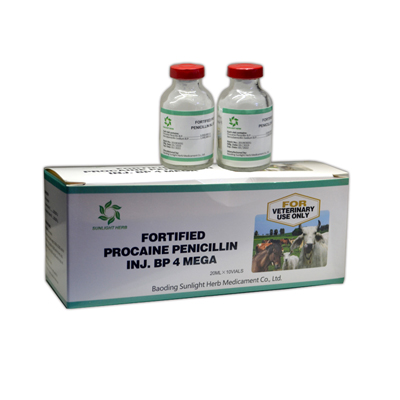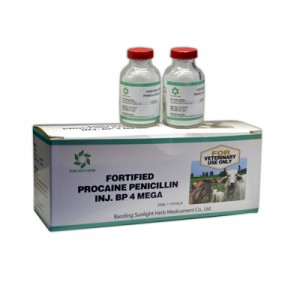Fortified Procaine Benzylpenicillin For Injecti
Fortified Procaine Benzylpenicillin For Injection
Composition:
Eeach vial contains:
Procaine penicillin b.p. ……………………… 3,000,000 i.u.
Benzylpenicillin sodium b.p. ……………… 1,000,000 i.u.
Description:
White or off-white sterile powder.
Pharmacological action
Penicillin is a narrow-spectrum antibiotic that acts primarily on a variety of gram-positive bacteria and a few gram-negative cocci. the main sensitive bacteria are staphylococcus, streptococcus, mycobacterium tuberculosis, corynebacterium, clostridium tetanus, actinomycetes, bacillus anthracis, spirochetes, etc. it is not sensitive to mycobacteria, mycoplasma, chlamydia, rickettsia, nocardia, fungi and viruses. pharmacokinetics after the intramuscular injection of procaine penicillin, it is slowly absorbed after releasing penicillin by local hydrolysis. the peak time is longer, the blood concentration is lower, but the effect is longer than penicillin. it is limited to pathogens that are highly sensitive to penicillin and should not be used to treat serious infections. after procaine penicillin and penicillin sodium (potassium) are mixed into injection, the blood concentration can be increased in a short period of time, giving both long-acting and quick-acting effects. large amount of injection of procaine penicillin can cause procaine poisoning.
Pharmacodynamics penicillin is a bactericidal antibiotic with strong antibacterial activity. its antibacterial mechanism is mainly to inhibit the synthesis of bacterial cell wall peptidoglycan. the sensitive bacteria in the growth stage are vigorously divided, and the cell wall is in the biosynthesis stage. under the action of penicillin, the synthesis of the peptidoglycan is blocked and the cell wall cannot be formed, and the cell membrane is broken and died under the action of osmotic pressure.
Penicillin is a narrow-spectrum antibiotic that acts primarily on a variety of gram-positive bacteria and a few gram-negative cocci. the main sensitive bacteria are staphylococcus, streptococcus, mycobacterium tuberculosis, corynebacterium, clostridium tetanus, actinomycetes, bacillus anthracis, spirochetes, etc. it is not sensitive to mycobacteria, mycoplasma, chlamydia, rickettsia, nocardia, fungi and viruses.
pharmacokinetics after the intramuscular injection of procaine penicillin, it is slowly absorbed after releasing penicillin by local hydrolysis. the peak time is longer, the blood concentration is lower, but the effect is longer than penicillin. it is limited to pathogens that are highly sensitive to penicillin and should not be used to treat serious infections. after procaine penicillin and penicillin sodium (potassium) are mixed into injection, the blood concentration can be increased in a short period of time, giving both long-acting and quick-acting effects. large amount of injection of procaine penicillin can cause procaine poisoning.
Drug Interaction
1. Penicillin combined with aminoglycosides can increase the concentration of the latter in the bacteria, so it has a synergistic effect.
2. Fast-acting bacteriostatic agents such as macrolides, tetracyclines and amide alcohols have an interference effect on the bactericidal activity of penicillin and should not be used together.
3. Heavy metal ions (especially copper, zinc, mercury), alcohols, acids, iodine, oxidants, reducing agents, hydroxy compounds, acidic glucose injection or tetracycline hydrochloride injection can destroy the activity of penicillin, which is a contraindication.
4. Amines and penicillins can form insoluble salts, which change the absorption. this interaction can delay the absorption of penicillin, such as procaine penicillin.
5. And some drug solutions (such as chlorpromazine hydrochloride, lincomycin hydrochloride, norepinephrine tartrate, oxytetracycline hydrochloride, tetracycline hydrochloride, b vitamins and vitamin c) should not be mixed, otherwise it can produce turbidity, floc or precipitation.
Indications
Mainly used for chronic infection caused by penicillin-sensitive bacteria, such as pus in the uterus for cows, mastitis, complex fractures, etc., also used for infections caused by actinomycetes and leptospira.
usage and dosage
For intramuscular injection.
Single dose, per kg body weight, 10,000 to 20,000 units for horse and cattle; 20,000 to 30,000 units for sheep, pigs, donkeys and calf; 30,000 to 40,000 units for dogs and cats. once daily, for 2-3 days.
add suitable amount of sterile water for injection to make a suspension before use.
Adverse Reactions
1. The main adverse reaction is allergic reaction, which can occur in most livestock, but the incidence is low. the local reaction is characterized by edema and pain at the injection site, and the systemic reaction is urticaria and rash. in severe cases, it may cause shock or death.
2. For some animals, it can induce a double infection of the gastrointestinal tract.
Cautions
1. This product is only used to treat chronic infections caused by highly sensitive bacteria.
2. It is lightly soluble in water. when contacting with acid, alkali or oxidant, it will quickly lose efficacy. therefore, the injection should be prepared before use.
3. Pay attention to the interaction and incompatibility with other drugs, so as not to affect the efficacy.
withdrawal period
Cattle, sheep, and pigs: 28days;
For milk: 72 hours.
Storage:
Sealed and kept in a dry place.


